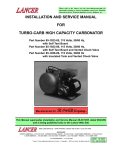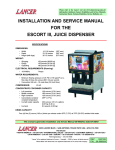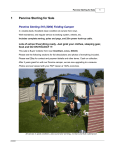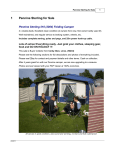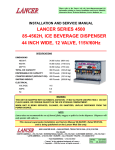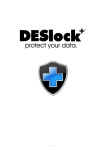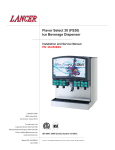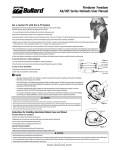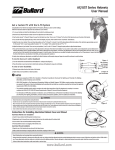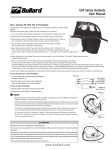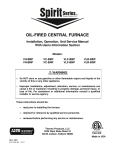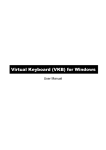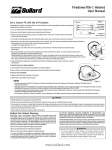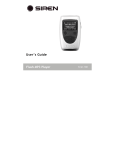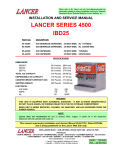Download installation and service manual for two liter premix
Transcript
Please refer to the Lancer web site (www.lancercorp.com) for information relating to Lancer Installation and Service Manuals, Instruction Sheets, Technical Bulletins, Service Bulletins, etc. INSTALLATION AND SERVICE MANUAL FOR TWO LITER PREMIX PUSH CART (Part Number 85-1751) This manual is an initial release 6655 LANCER BLVD. • SAN ANTONIO, TEXAS 78219 USA • (210) 310-7000 FAX SALES • NORTH AMERICA – 210-310-7245 • INTERNATIONAL SALES – 210-310-7242 • CUSTOMER SERVICE – 210-310-7242 • • LATIN AMERICA – 210-524-9567 / 210-310-7245 • EUROPE – 32-2-755-2399 • PACIFIC – 61-8-8268-1978 • FAX ENGINEERING: • 210-310-7096 "Lancer" is the registered trademark of Lancer • Copyright — 1997 by Lancer, all rights reserved. DATE: P.N. 01/27/97 28–0325 TABLE OF CONTENTS TABLE OF CONTENTS ......................................................................................................................................i SPECIFICATIONS...............................................................................................................................................i 1. PACKAGING AND INSPECTION................................................................................................................1 1.1 RECEIVING AND UNPACKING .........................................................................................................1 1.2 COMPONENTS..................................................................................................................................1 2. ASSEMBLY..................................................................................................................................................1 2.1 ASSEMBLY INSTRUCTIONS ............................................................................................................1 2.2 CO2 REGULATOR ASSEMBLY .........................................................................................................3 2.3 CUTTING THE BOTTLE TUBES .......................................................................................................3 3. OPERATION ................................................................................................................................................4 3.1 CUP DISPENSER ..............................................................................................................................4 3.2 DISPENSING VALVE .........................................................................................................................4 3.3 CO2 PRESSURE ASSEMBLY............................................................................................................4 3.4 CO2 PRODUCT BOTTLES AND CO2 CYLINDER EXCHANGE .......................................................4 3.5 CO2 CYLINDER REFILL PROCEDURE ............................................................................................5 3.6 UNLOADING 2 LITER PET BOTTLES FROM PUSH CART ICE CUBE COOLER ..........................5 4. MAINTENANCE...........................................................................................................................................7 4.1 CUP DISPENSER ..............................................................................................................................7 4.2 CLEANING AND SANITIZING ...........................................................................................................7 4.3 REPLACEMENT OF BEVERAGE HOSE INSIDE DISPENSING VALVE ASSEMBLY......................7 4.4 CO2 CYLINDER .................................................................................................................................7 4.5 CO2 REGULATOR ASSEMBLY .........................................................................................................8 5. ILLUSTRATIONS, PARTS LISTINGS, AND WIRING DIAGRAMS ..........................................................10 5.1 COOLER AND HARDWARE .......................................................................................................10-11 5.2 CO2 CYLINDER ASSEMBLY ...........................................................................................................11 5.3 REGULATOR ASSEMBLY ...............................................................................................................12 5.4 CONNECTOR VALVE ASSEMBLY ..................................................................................................12 5.5 DISPENSING VALVE ASSEMBLY ...................................................................................................13 5.6 CUP DISPENSER ASSEMBLY ........................................................................................................13 5.7 REFILL ADAPTER ASSEMBLY .......................................................................................................14 5.8 PRESSURE GAUGE TESTING ASSEMBLY ...................................................................................14 SPECIFICATIONS CARBON DIOXIDE (CO2) REQUIREMENTS Pressure Regulator Setting Relief Valve Setting CO2 Cylinder Capacity CO2 Cylinder Refill 22 PSI (Preset) 30 PSI (Preset) 10 ounces of liquid CO2 (Sufficient for 5 complete discharges of each dispensing system) Use 50 pound CO2 Bottle with a dip tube DRINK CAPACITY The system consists of two (2) independent banks of five (5) two (2) liter bottles. Each bank is capable of providing 34 - 12 ounce cups or 24 - 16 ounce cups per one complete discharge using no ice in cup. i 1. PACKAGING AND INSPECTION 1.1 RECEIVING AND UNPACKING Open shipping case and carefully remove beverage dispenser components. Each unit has been thoroughly inspected and tested prior to shipment. Inspect all items for damage. In the event of shortage or damage, notify the delivering carrier (as well as Lancer) immediately. Merchandise should be inspected for concealed damage no later than 15 days after receipt. 1.2 COMPONENTS A. B. C. D. E. Installation and Service Manual CO2 Cylinders Dispensing Valve Assemblies - two (2) CO2 Regulator Assemblies - two (2) Eight (8) Bottle Connector/Valve Assemblies F. Cup Dispenser G. Graphics Panel (Optional) H. Refill Adapter (Optional) I. Pressure Gauge Assembly (Optional) 2. ASSEMBLY 2.1 ASSEMBLY INSTRUCTIONS A. Unpack the push cart and check the items received against the parts list. B. Assemble the push cart per the Instruction Sheet included with cart. NOTE The riser is supplied mounted to the Push Cart. C. Install the cup rest bracket on the push cart riser. Fully Assembled Push Cart Side View Figure 1 NOTE The cup rest bracket sits on the riser, with the angle flange of the bracket inside the riser, the cube resting on the bracket to hold it down. D. Unpack the cup dispenser, and install the two mounting brackets on the push cart handle. The smaller tapered end of the bracket should be facing down. E. Unpack the cube, being careful to not damage the dispensing valves while unpacking. Place the cube on the riser, and on the angle flange of the cup dispenser. F. Place the drip tray in the cup rest bracket. Place the wire cup rest in the drip tray. G. Place the cup dispenser on the two mounting brackets. The black end of the cup dispenser is up (i.e., the cups are displaced up). Place cups in the cup dispenser. 1 Fully Assembled Push Cart Backside View Figure 2 H. Place the trash bin on the front of the cart as shown. I. Install the (optional) umbrella in the mounting bracket. J. Remove the caps of eight (8) 2 liter beverage products. Screw on the eight connector valve bottle fitting assemblies. SPRINGS ATTACH VALVES TO THESE LOCATIONS CAUTION DO NOT OVER TIGHTEN THE FITTINGS. OVER TIGHTENING CAN CAUSE LEAKS! PLACE THESE BOTTLES IN THE SPRING FRAME AS SHOWN. SPRINGS Bottle Hold Down Springs and Bottle Placement K. Remove the caps of two (2) 2 liter products. Screw the bottle onto the Figure 3 connector valve bottle fittings inside the cube that are connected to the dispensing valves. Place these two bottles in the spring frame farthest away from the valves (see Figure 3). NOTE Place the four (4) corner bottles in first. Then put the bottles in between them. Then put the four (4) center bottles in. L. Reverse this order to remove the bottles. M. Charge the two CO2 cylinders following the instructions on the cylinders. CAUTION BE SURE TO WEIGH THE CYLINDERS AFTER CHARGING. THE FILLED WEIGHT MUST NOT EXCEED 1.0 KG, OR 2 LB., 3 OZ. FAILURE TO KEEP THE WEIGHT BELOW THIS AMOUNT COULD RESULT IN OVERPRESSURE OF THE CYLINDER, AND CAUSE THE SAFETY RELIEF VALVE TO OPEN. IN QUICK DISCONNECT CYLINDER COUPLING PR E S E T TO 2 2 P SI WARNING CONTENTS UNDER PRESSURE HANDLE WITH CARE RESET TO 22 PSI PR E S E T TO 2 2 P SI NOTE: MAXIMUM CYLINDER WEIGHT FULL, SHOULD NOT EXCEED 2 LB. 3 OZ.(1.0 KG.) LANCER PN 06-1213 REGULATOR ASSEMBLY T OU RESET TO 22 PSI CO2 FILLING INSTRUCTIONS WARNING CONTENTS UNDER PRESSURE HANDLE WITH CARE NOTE: MAXIMUM CYLINDER WEIGHT FULL, SHOULD NOT EXCEED 2 LB. 3 OZ.(1.0 KG.) LANCER PN 06-1213 NOTE: CO2 BOTTLE MUST HAVE A DIP TUBE, OR IT MUST BE INVERTED, TO INSURE FILLING THE SMALL CO2 CYLINDER WITH LIQUID. TO FILL: CO2 CYLINDER CO2 BOTTLE CO2 BOTTLE VALVE FILL ADAPTER VENT VALVE CO2 CYLINDER VALVE FILL ADAPTER WARNING CONTENTS UNDER PRESSURE HANDLE WITH CARE NOTE: MAXIMUM CYLINDER FULL SHOULD NOT 2 LB. 3 OZ. (1.0 KG.) TO FILL: 1) CLOSE THE THE REFI 2) CONNECT TO THE 3) OPEN CO 4) OPEN VALVE WITH THE 5) OPE THE CO CLO 6) OP BOT GA 7) CLO CO 2 8) CLO CO 2 9) OP THE 10) DIS CYL AD 11) WE THE BE 2 IF IT THE AND SPEC CO 2 BOTTLE WITH DIP TUBE Quick Disconnect Cylinder Coupling 2 CO2 CYLINDER ASSEMBLY N. Place the two cylinders in the spring frame as shown. Connect a regulator assembly to each of the cylinder assemblies, by pulling back on the quick disconnect body on the regulator, and pushing it on the stem on the cylinder assembly. O. Connect the regulator assembly and the bottles in series as follows: Plug the hose end of the regulator assembly into the fitting on the bottle fitting assembly, on the center bottle farthest away from the CO2 cylinder. Plug the hose end from that bottle into the corner bottle next to the dispensing valves. Plug the hose end from that bottle into the center bottle along the side. Plug the hose end from that bottle into the center bottle next to the CO2 cylinder. Plug the hose end from that bottle into the bottle with the hose that connects to the valves. Make sure the dispensing valves are closed. P. Open the CO2 cylinder valve. Check for leaks. Q. Make sure the drain plug is in the drain hole in the bottom of the cube. Cover with ice as required. 45 o MEASUREMENT DISTANCE Cutting the Bottle Tube Figure 5 NOTE Do not allow water to rise above the spring frame. 2.2 CO2 REGULATOR ASSEMBLY A. Attach CO2 Regulator Assembly to CO2 Cylinder, utilizing Quick Disconnect Cylinder Coupling (see Figure 4). B. Pull back Socket Sleeve to connect or disconnect coupling. CONNECTOR VALVE ASSEMBLY NOTE Do not attempt to disconnect cylinder coupling while under pressure. Coupling will not disconnect. 2.3 CUTTING THE BOTTLE TUBES Cutting the bottle tubes to the correct length is an important step. Bottle tubes are supplied as loose items, to be cut by the user to the correct length for the height of the bottles being used. Use the following procedure when cutting the bottle tubes (see Figure 5): PREMIX BOTTLE (CUSTOMER SUPPLIED) A. Measure from the very bottom of an empty bottle, to the top of the bottle. Connector Valve Assembly Figure 6 3 B. C. D. E. Cut the tubes 7/8 inch (22 mm) shorter than the height measured just above. If the end of the tube is not already cut at an angle, carefully cut the tube at a 45° angle. Push the tube onto the barbed end of the connector/valve bottle fitting assembly. Slowly open the valve on the CO2 cylinder. Check for leaks. Close the lid of the cooler. 3. OPERATION 3.1 CUP DISPENSER The Cup Dispenser will hold cup sizes ranging between 12 and 20 ounces in capacity. 3.2 DISPENSING VALVE The Dispensing Valve will dispense any type of beverage product. Beverage flow is controlled by turning the Flow Screw on the Valve Body until desired flow is maintained (see Figure 8). The Product Hose is insulated to maintain constant product temperature regardless of environmental conditions. The Valve operates by pulling the handle forward, and upon release, the Valve will automatically close. 3.3 CO2 PRESSURE ASSEMBLY All beverage products are dispensed utilizing CO2 pressure. Each CO2 Cylinder has a rated capacity of ten (10) ounces of liquid CO2 gas, which is sufficient to dispense five (5) complete refills of any type beverage product. The empty CO2 Cylinder is then exchanged for a charged CO2 Cylinder. CO2 Cylinders may be refilled by the user through a fast, safe, and inexpensive method described in this manual, or CO2 Cylinders may be refilled by a local commercial liquid gas supplier. It is advisable to maintain a supply of charged CO2 Cylinders for quick exchange. The CO2 Cylinder is ICC approved and equipped with a Safety Diaphragm Relief Valve. A. Pressure Regulator setting The Regulator pressure is preset to 22 PSI. B. Safety Relief Valve setting The Safety Relief Valve is preset to 30 PSI. C. To disconnect CO2 cylinder from regulator assembly Follow the procedure below: (1) Close the Cylinder Valve. (2) Bleed off pressure through a Gas Socket. (3) Disconnect Cylinder, by pulling back sleeve on Cylinder Coupling. 3.4 CO2 PRODUCT BOTTLES AND CO2 CYLINDER EXCHANGE Empty beverage bottles and an empty CO2 Cylinder (when necessary) can be exchanged in about 30 seconds, upon the Vendor’s return to the refill station. NOTE The 2 liter push cart contains two independent dispenser systems. The total number of servings per cart is therefore 2X the numbers shown the chart in Figure 7. A. Open lid of ice cube cooler. B. Disconnect the lines to the connector valve assembly on each bottle. C. Remove the bottle with the hose to the dispensing valve. Unscrew the Connector/Valve Assembly from that bottle. D. Follow steps (1) through (6) below, if the CO2 Cylinder is to be exchanged. (1) (2) (3) (4) Remove CO2 Cylinder Assembly. Close Cylinder Valve. Bleed off pressure through Gas Socket. Disconnect empty Cylinder from Regulator Assembly (normally, the Cylinder is not 4 NUMBER OF SERVINGS BY SIZE OF INDIVIDUAL SERVING NUMBER OF SERVINGS PER COMPLETE REFILL ACTUAL PRODUCT SERVED IN OUNCES 12 34 16 24 Figure 7 completely empty, but do not bleed off as the small remaining amount is later used to facilitate refill). (5) Connect full (charged) Cylinder to Regulator Assembly. (6) Open Cylinder Valve and replace CO2 Assembly. E. F. G. H. 3.5 Remove empty product bottles and replace with full 2-liter bottles of Premix. Connect Dispensing Valve Assembly to a bottle, and place into the unit or cooler. Connect CO2 Assembly to bottle. Connect all lines to all bottles (see Figure 7). Close cover. Refill Cup Dispenser. CO2 CYLINDER REFILL PROCEDURE A. CO2 Cylinder Assembly (PN 20-0016). CO2 Cylinders may be refilled, following the outlined procedures below, at the rate of one (1) CO2 Cylinder per minute. The following equipment is necessary to utilize the refill method: NOTE The fill adapter (PN 17-0385/01) is designed to be placed on USA CO2 bottles with 0.830-14 NGO thread. If the threads are different on the CO2 bottles being used, it will be necessary to make an adapter to interface between the CO2 bottle being used and the adapter. An adapter is not supplied because of thread variances between bottles. It will be necessary to make an identical piece, with the threads on the female end identical to the threads on the CO2 bottle being used. (1) Fifty (50) pound CO2 supply bottle with a siphon (dip) tube. This should be available from any local commercial liquid gas supplier. A fifty (50) pound liquid CO2 bottle will normally refill approximately seventy to seventy-two (70 to 72) CO2 Cylinders. (2) CO2 Cylinder Refill Adapter (PN 17-0385/01). (3) Scale with minimum graduations of a quarter ounce (1/4 ounce). Although an accurate spring scale is acceptable, a triple beam balance scale is preferable. Either scale may be obtained at a nominal cost from local suppliers. B. Refill Procedure (see Figure 8) (1) Connect Refill Adapter to liquid CO2 supply bottle (50 pounds). (2) Connect empty CO2 Cylinder to Refill Adapter, utilizing Quick Disconnect Coupling. Close Refill Adapter Vent Valve. (3) Open CO2 Cylinder valve (PN 20-0016). (4) Open supply bottle valve for about three to five (3 to 5) seconds. Close valve. (5) Open Refill Adapter Vent Valve, allowing pressure to disperse. This chills the CO2 Cylinder. Close Refill Adapter Vent Valve. (6) Open supply bottle valve until CO2 Cylinder is filled (hissing sound will stop). Close supply bottle valve. 5 (7) Close CO2 Cylinder valve. (8) Open Refill Adapter Vent Valve. This disperses pressure. Disconnect CO2 Cylinder from Refill Adapter. NOTE CO2 FILLING INSTRUCTIONS NOTE: CO2 BOTTLE MUST HAVE A DIP TUBE, OR IT MUST BE INVERTED, TO INSURE FILLING THE SMALL CO2 CYLINDER WITH LIQUID. CO2 Cylinder will not disconnect from Refill Adapter unless Refill Adapter Vent Valve has been opened. TO FILL: (1) CLOSE THE FILL ADAPTOR VENT. CO2 CYLINDER CO 2 BOTTLE CO2 BOTTLE VALVE FILL ADAPTER VENT VALVE CAUTION CO2 CYLINDER VALVE DO NOT OPERATE CO2 CYLINDER WHEN GROSS WEIGHT IS IN EXCESS OF THAT INDICATED ON THE CO2 CYLINDER. THE CO2 CYLINDER IS ICC APPROVED AND EQUIPPED WITH A SAFETY DIAPHRAGM RELIEF VALVE. IF OPERATED OR STORED WHEN THE WEIGHT IS IN EXCESS OF THAT RECOMMENDED, SEVERE HEAT MAY CAUSE THE SAFETY DIAPHRAGM RELIEF VALVE TO OPEN; THEREBY, DISPERSING EXCESSIVE PRESSURE. REFER TO MAINTENANCE SECTION, AND PARTS AND SERVICE SECTION, FOR INSTRUCTIONS ON REPLACING DIAPHRAGM. FILL ADAPTER (2) CONNECT THE SMALL CO 2 CYLINDER TO THE FILL ADAPTER. (3) OPEN THE VALVE ON THE SMALL CO2 CYLINDER VALVE. (4) OPEN THE CO2 BOTTLE VALVE FOR 5 SECONDS. CLOSE THE VALVE. (5) OPEN THE FILL ADAPTER VENT VALVE (THIS COOLS THE CO 2 CYLINDER). CLOSE THE VENT VALVE. (6) OPEN THE CO2 BOTTLE VALVE (LISTEN FOR THE GAS FLOW TO STOP). (7) CLOSE THE CO2 CYLINDER VALVE. (8) CLOSE THE CO2 BOTTLE VALVE. (9) OPEN THE FILL ADAPTER VENT VALVE. WARNING CONTENTS UNDER PRESSURE HANDLE WITH CARE NOTE: MAXIMUM CYLINDER FULL SHOULD NOT 2 LB. 3 OZ. (1.0 KG.) (10) DISCONNECT THE CO2 CYLINDER FROM THE FILL ADAPTER. TO FILL: 1) CLOSE THE THE REFI 2) CONNECT TO THE 3) OPEN CO 4) OPEN VALVE WITH THE 5) OPE THE CO CLO 6) OP BOT GA 7) CLO CO 2 8) CLO CO 2 9) OP THE 10) DIS CYL AD 11) WE THE BE 2 IF IT THE AND SPEC (11) WEIGH THE CO2 CYLINDER. THE MAXIMUM WEIGHT ALLOWABLE IS 1.0 KG (2 LB., 3 OZ.). IF THE CYLINDER IS OVERWEIGHT, OPEN THE VALVE TO EXHAUST GAS. RE-WEIGH THE CYLINDER. CO 2 BOTTLE WITH DIP TUBE REPEAT AS REQUIRED TO REACH SPECIFIED WEIGHT. CO2 Filling Instructions Figure 8 (9) Weigh CO2 Cylinder. If gross weight is over that indicated on the CO2 Cylinder, bleed off pressure until referenced weight is achieved. The CO2 Cylinder now contains ten (10) ounces of liquid CO2 which is sufficient to dispense five (5) complete refills of any type beverage. 3.6 UNLOADING 2 LITER PET BOTTLES FROM PUSH CART ICE CUBE COOLER A. Release the quick disconnects from the bottle fittings. B. Remove the empty bottles from the cube. WARNING UNVENTED BOTTLES CAN BECOME PROJECTILES. CAUTION VENTING OF THE BOTTLE MUST OCCUR IMMEDIATELY WHEN THE FITTING IS TURNED 1/8 OF A TURN. IF VENTING DOES NOT TAKE PLACE, DEPRESS THE END OF THE QUICK DISCONNECT TO VENT. C. Remove the bottle fitting from the bottles. 4. MAINTENANCE 4.1 COOLER AND LID A. Scuff and dirt marks are readily and easily removed with a damp cloth and mild detergent, although stubborn marks may require a cleaner. At the end of each day’s activity, the unit should be cleaned and allowed to air dry prior to storage. B. To drain the cube, pull out the plug in the bottom of the cube. The water will drain out of the bottom, through the riser, and through a pipe in the center of the riser. If the cube is removed and tipped to dump the ice, be careful to not damage the dispensing valves. 6 4.2 CUP DISPENSER A. The Cup Dispenser should be cleaned periodically with a damp cloth and detergent, or cleaner. The Cup Dispenser is constructed of Stainless Steel which helps to ensure a rust and corrosion free operation. B. See Section 5 for parts breakdown and related information. 4.3 CLEANING AND SANITIZING A. Bottles are to be discarded after each use. However, five (5) empty 2-liter bottles must be retained for cleaning and sanitizing the unit. B. Prepare a sanitizing solution of between 50 to 150 PPM of available chlorine, not to exceed 200 PPM and fill one (1) bottle with sanitizing solution. C. Assemble four (4) empty product bottles into the hold down frame. Place the remaining product bottle (filled with sanitizing solution in Step B above) into the frame and connect to the CO2 Cylinder/Regulator Assembly. D. Connect the CO2 cylinder/pressure regulator to the bottle with sanitizing solution. E. Connect the four (4) empty, de-pressurized bottles in series, downstream of the sanitizer bottle. F. Turn on the valve on the CO2 cylinder. G. Activate the dispensing valve until all the sanitizing solution has been dispensed through the system. H. Shut off the CO2. I. Depressurize by opening the dispensing valve until all pressure is exhausted. J. Unscrew the connector/valve assembly from each bottle. Drain all sanitizing solution from each assembly. Drain the cube by pulling the plug in the bottom of the cube. NOTE If necessary, push the end of the male fitting of the connector/valve assembly to allow the liquid solution to drain from the hoses of the connector/valve assembly. Also drain the dispensing valve hose assembly. J. Rinse the exterior of all bottle fittings with the sanitizing solution. K. Air dry in a clean environment. Cover if necessary. 4.4 CO2 CYLINDER CAUTION FOR THE FOLLOWING PROCEDURE, DO NOT HOLD THE CO2 CYLINDER WITH A JAW TYPE WRENCH, OR A VISE. A JAW TYPE WRENCH WILL MAR THE CYLINDER, WEAKEN THE CYLINDER WALL, AND POSSIBLY CAUSE A FAILURE. CLAMPING THE CO2 CYLINDER IN A VISE WILL CRUSH THE CYLINDER, AGAIN WEAKENING THE CYLINDER WALL, AND WILL RESULT IN CYLINDER FAILURE. HOLD THE CO2 CYLINDER WITH A STRAP WRENCH. THE STRAP WRENCH WILL HAVE A LEATHER OR CLOTH TYPE STRAP, THAT WILL NOT MAR THE CYLINDER SURFACE. The CO2 Cylinder used by the cart is virtually free of maintenance. If any maintenance is required, other than that described below, return the CO2 Cylinder to Lancer for repair. A. Safety Diaphragm Relief Valve If the Safety Diaphragm Relief Valve leaks, or the Diaphragm has ruptured due to extreme pressure, follow the instructions provided below. For a parts breakdown, see Section 5. The safety relief valve is not replaceable. In the event this valve ruptures or leaks, replace the complete valve (PN 17-0514) as follows: (1) Open Cylinder Valve and exhaust all CO2 pressure. (2) Remove adapter from the CO2 valve. 7 (3) Remove the CO2 valve. NOTE Hold the CO2 cylinder with a strap wrench as noted above. (4) Install new CO2 valve. Torque to 20.0 ft lbs. (5) Install adapter. Torque to 20.0 ft lbs. (6) Charge the CO2 cylinder. Check for leaks. B. Repairing Leaks on the CO2 Cylinder Assembly If a leak should occur because of a failed O-Ring, replace the defective O-Ring: (1) Between the cylinder and the CO2 valve. a. Open the CO2 cylinder valve to exhaust all of the CO2 pressure. b. Remove the CO2 valve from the cylinder. NOTE Hold the CO2 cylinder with a strap wrench as noted above. c. Replace the O-Ring (PN 02-0219) on the valve. d. Lubricate the O-Ring slightly with a silicone spray. e. Install the valve on the cylinder. Torque to 20.0 ft lbs. (2) Between the CO2 valve and the adapter. a. b. c. d. Open the CO2 cylinder valve to exhaust all of the CO2 pressure. While holding the CO2 valve with a wrench, remove the adapter. Replace the O-Ring (PN 02-0003). Install the adapter on the valve. Torque to 20.0 ft lbs. (3) For any other leaks, return the CO2 cylinder assembly to Lancer. 4.5 CO2 REGULATOR ASSEMBLY For Parts breakdown and related information, see Section 5. A. Hose Connector If leakage occurs in the Hose Connector, replace the Hose Connector and hose. B. CO2 Cylinder Coupling (Socket) If leakage occurs between the Socket and the Plug, when the CO2 Regulator assembly is coupled with the CO2 Cylinder, disconnect and visually inspect the Socket O-Ring. If the O-Ring is nicked, cut, or otherwise defective, replace the O-Ring. C. CO2 Regulator CO2 Regulators cannot be disassembled for maintenance without special equipment and should be returned to Lancer for any needed repair. The following procedure can be used to check the regulator pressure. (1) A pressure gauge testing assembly (PN 82-1751) is available to check the relief valve/regulator pressure (see Section 5.8). (2) If it is necessary to check or readjust the pressure, follow these steps: NOTE The pressure testing assembly is to be used to check the pressure of the regulator assembly only if the pressure from the regulator assembly (PN 18-0274) is not correct. (a) Plug the pressure testing assembly onto the male fitting of the regulator assembly. (b) On the CO2 cylinder, turn on the valve. The pressure of the regulator should be 22 PSI. 8 (3) (4) (5) (6) (7) (8) (9) IN (c) If necessary, readjust the regulator to the correct pressure, by loosening the locknut, adjusting the screw to the correct pressure, then tighten the locknut. Plug the gauge assembly onto the regulator assembly (see Figure 9). Connect the regulator assembly to a CO2 cylinder assembly. Open the CO2 cylinder valve. The regulator pressure valve should be at 22 PSI, + 3 PSI. To reset, back off the lock nut on the regulator, and back out the adjusting screw. Disconnect the gauge assembly, and push in the end of the male fitting to relieve the pressure in the regulator assembly. Connect the gauge assembly. Turn the adjusting screw until the correct pressure is obtained T OU Pressure Testing Figure 9 (10)Lock the adjusting screw with the lock nut. D. Relief Valve/Check valve The relief valve/check valve cannot be field repaired. In the event of failure, replace with a new valve (PN 17-0517). The relief pressure is preset, and is not to be field adjusted. NOTES Please refer to the Lancer web site (www.lancercorp.com) for information relating to Lancer Installation and Service Manuals, Instruction Sheets, Technical Bulletins, Service Bulletins, etc. 9 10 8 10 21 [TYPICAL THREE (3) SIDES] 19 20 9 15 1 12 9 7 13 5 (REF) 14 8 6B 2 11 A IN 5 6A T OU T 10 R RADEMARKS 3 16 12 (REF) 4 5 IN T OU 2 P R ES E T 22 P S I SI 17 3 4 5.1 TO P TO 22 18 5. ILLUSTRATIONS, PARTS LISTINGS, AND WIRING DIAGRAMS COOLER AND HARDWARE 5.1 ITEM COOLER AND HARDWARE (CONTINUED) ITEM PART NO. DESCRIPTION 1 2 3 4 5 6 23-0918 20-0016 18-0274 17-0509 17-0526 19-0003 7 8 9 10 11 05-0011 13-0087 01-1369 04-0811 30-6314 Cube Assy, with Covers Cylinder Assy Regulator Assy Connector/Valve Assy Connector/Valve Assy, to Valve Dispensing Valve, with Handle (includes attaching nut) Washer Retainer, Standoff Lock Clip Elbow Adapter Insert, Push In, Barbed Plate, Hold Down 5.2 PART NO. DESCRIPTION 12 13 14 82-1785 30-6302 04-0816 15 16 17 18 19 20 21 04-0448 82-1184 03-0260 03-0261 03-0262 05-1196 04-0815 Assy, Frame, Hold Down Plate, Front Escutcheon Screws, Self-Tapping, 8 x 0500, TEK Screw, 8 - 32 x 0.250 LG Kit, Label, 8 Flavor Spring A, Bottle Hold Down Spring B, Bottle Hold Down Spring C, Cylinder Hold Down Molding, J-Shaped Poprivets, 1/8 inch, Aluminum CO2 CYLINDER ASSEMBLY 7 6 5 4 3 WARNING CONTENTS UNDER PRESSURE HANDLE WITH CARE 8 NOTE: MAXIMUM CYLINDER WEIGHT FULL, SHOULD NOT EXCEED 2 LB. 3 OZ.(1.0 KG.) LANCER PN 06-1213 1 9 CO2 FILLING INSTRUCTIONS NOTE: CO2 BOTTLE MUST HAVE A DIP TUBE, OR IT MUST BE LAID ON ITS SIDE, TO INSURE FILLING THE SMALL CO2 CYLINDER WITH LIQUID. TO FILL: (1) CLOSE THE FILL ADAPTOR VENT. CO2 BOTTLE VALVE FILL ADAPTER VENT VALVE (3) OPEN THE VALVE ON THE SMALL CO 2 CYLINDER. (4) OPEN THE CO2 BOTTLE VALVE FOR 5 SECONDS. CLOSE THE VALVE. CO2 CYLINDER VALVE 2 ITEM 1 2 3 4 5 6 7 8 9 PART NO. DESCRIPTION 20-0016 20-0015 02-0219 17-0514 02-0003 01-1620 17-0518 06-1213 06-1218 CO2 Cylinder Assy Cylinder O-Ring Valve, CO2 O-Ring Adapter Plug Fitting Label, Warning Label, How to Fill (2) CONNECT THE SMALL CO 2 CYLINDER TO THE FILL ADAPTER. (5) OPEN THE FILL ADAPTER VENT VALVE (THIS COOLS THE CO 2 CYLINDER). CLOSE THE VENT VALVE. CO2 CYLINDER WARNING CONTENTS UNDER PRESSURE HANDLE WITH CARE FILL ADAPTER CO 2 BOTTLE NOTE: MAXIMUM CYLINDER FULL SHOULD NOT 2 LB. 3 OZ. (1.0 KG.) (6) OPEN THE CO2 BOTTLE VALVE (LISTEN FOR THE GAS FLOW TO STOP). TO FILL: 1) CLOSE THE THE REFI 2) CONNECT TO THE 3) OPEN CO 4) OPEN VALVE WITH THE 5) OPE THE CO CLO 6) OP BOT GA 7) CLO CO 2 8) CLO CO 2 9) OP THE 10) DIS CYL AD 11) WE THE BE 2 IF IT THE AND SPEC (7) CLOSE THE CO2 CYLINDER VALVE. (8) CLOSE THE CO2 BOTTLE VALVE. CO 2 BOTTLE WITH DIP TUBE (9) OPEN THE FILL ADAPTER VENT VALVE. (10) DISCONNECT THE CO2 CYLINDER FROM THE FILL ADAPTER. (11) WEIGH THE CO 2 CYLINDER. THE MAXIMUM WEIGHT ALLOWABLE IS 1.0 KG (2 LB., 3 OZ.). IF THE CYLINDER IS OVERWEIGHT, OPEN THE VALVE TO EXHAUST GAS. RE-WEIGH THE CYLINDER. REPEAT AS REQUIRED TO REACH SPECIFIED WEIGHT. 11 5.3 REGULATOR ASSEMBLY 2 ITEM 3 4 5 IN 6 T OU 7 8 1 2 3 4 5 6 7 8 9 10 PART NO. DESCRIPTION 18-0274 02-0005 17-0519 18-0273 06-1214 17-0517 07-0504 08-0321 07-0504 17-0508 Regulator Assy O-Ring Coupling, Quick Disconnect Regulator Valve Label Relief/Backflow Check Valve Clamp Hose Clamp Fitting, Plug PRESET T O 2 2 PSI 9 10 1 3 2 5.4 ITEM 1 2 3 4 5 6 7 8 9 10 11 12 13 CONNECTOR VALVE ASSEMBLY PART NO. DESCRIPTION 17-0509 17-0507 07-0504 17-0508 08-0321 07-0504 03-0191 04-0756 02-0419 05-1072 02-0158 01-1604 08-0322 Connector Valve Assy Fitting, Coupling Clamp Fitting, Plug Hose, Out Clamp Clip, Retainer Washer O-Ring Connector/Valve Body O-Ring Fitting, Connector/Valve Body Hose, Bottle 5 6 7 8 9 9 1 10 11 12 13 12 4 5.5 DISPENSING VALVE ASSEMBLY 7 6 5 8 4 ITEM 1 2 3 4 5 6 7 8 SEE CALLOUTS IN SECTION 5.4 5.6 CUP DISPENSER ASSEMBLY 1 ITEM 1 PART NO. DESCRIPTION 23-0935 Cup Dispenser Assy 13 3 1 2 PART NO. DESCRIPTION 19-0003 05-0011 01-0221 01-0222 07-0504 88-0133 08-0325 53-0008 Valve, Dispensing Washer Hose Stem Nut Clamp Insulation, Hose Hose, Dispensing Valve Sleeve 5.7 REFILL ADAPTER ASSEMBLY 2 3 7 4 5 6 8 9 1 ITEM 1 2 3 4 5 6 7 8 9 5.8 PART NO. DESCRIPTION 17-0385/01 02-0005 17-0519 02-0140 01-0283 07-0007 17-0520 01-1643 02-0342 Refill Adapter Assy O-Ring Coupling, Quick Disconnect O-Ring Screen Retainer Screen Vent Valve Body, Refill Adapter Washer PRESSURE GAUGE TESTING ASSEMBLY 2 3 4 1 ITEM 1 2 3 4 PART NO. DESCRIPTION 82-1751 16-0025 01-1631 17-0524 Pressure Gauge Testing Assy Gauge Coupling Fitting, Coupling 14
















